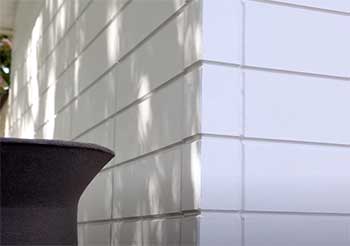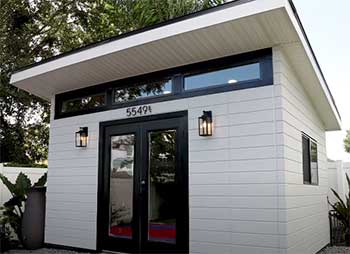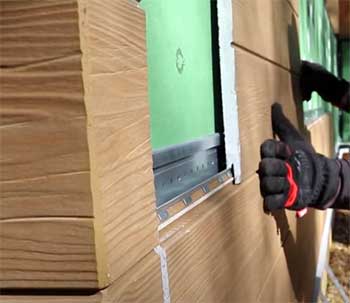Nichiha fiber cement siding is a popular alternative to traditional wood or vinyl siding for homes. Made from a mixture of cement, sand, and cellulose fibers, Nichiha siding is known for its durability, low maintenance, and aesthetically pleasing look.
However, like any building material, Nichiha siding is not without its potential drawbacks and issues. In this comprehensive guide, we’ll explore some of the most common Nichiha siding problems homeowners report, plus tips for prevention and repair.
Problems With Nichiha Siding
Here is a list of these issues:
- Fading and Discoloration
- Cracking Issues
- Moisture Damage and Rotting
- Problems With Improper Installation
- Efflorescence
- Mold and Mildew Growth
- Storm and Impact Damage
- Delamination Issues
- Chalking Over Time
- Efforts at Prevention
Let’s talk about them in detail.
Fading and Discoloration

One of the most frustrating Nichiha siding issues homeowners face is fading or discoloration of the siding over time.
While the cement-based material is quite colorfast, prolonged exposure to intense sunlight can cause subtle fading and slight color changes.
Areas of siding facing south or west tend to be most susceptible.
Discoloration issues may be more noticeable if there are already variations in color between siding boards.
There are a few ways homeowners can help minimize Nichiha siding fade:
- Use lighter, more UV-resistant colors like whites and grays rather than darker hues.
- Ensure siding gets washed regularly to prevent dirt buildup.
- Apply protective sealers or UV inhibitors annually.
- Plant trees or shrubs to shade intense afternoon sun exposure.
If fading or discoloration becomes significant, the siding boards may need to be replaced and/or repainted. Be sure to use high-quality exterior grade paints and follow preparation guidelines if repainting Nichiha siding.
Cracking Issues
One of the most common siding problems with any material is cracking. Minor cracks and hairline fractures can develop in Nichiha cement fiber boards over time. There are several potential causes:
- Settling, movement, or shifting of the home’s structure over many years. Even slight foundation changes can stress siding.
- Impact damage from objects hitting the siding.
- Improper installation or siding not properly secured. Gaps can allow movement and board warping.
- Extreme weather like hail storms or high winds that exert force on the siding.
- Wide temperature swings and other seasonal environmental factors that cause contraction and expansion of the boards.
Many minor cracks in Nichiha siding are purely cosmetic and do not require any action. However, larger cracks should be sealed to prevent water intrusion and further damage. Silicone-based caulks and sealants designed for exterior use are ideal.
In extreme cases where cracking is widespread, siding boards may need replacing. Proper installation is key to preventing cracks in new siding projects.
Moisture Damage and Rotting
While Nichiha fiber cement boards hold up better to moisture than natural wood siding, ongoing exposure can still take a toll over time. Indications of moisture damage include:

- Bubbling, cracking, or peeling paint
- Discoloration, staining, or dark spots
- Visible mold, mildew, or algae growth
- Spongy, warped, or rotting spots in the siding
Preventing moisture damage starts with proper Nichiha siding installation.
A good weather barrier, adequate flashing, and sufficient caulking are musts.
Ensuring rain and irrigation sprinklers are not constantly soaking the siding is also important.
Promptly cleaning and repairing any deteriorated caulk or paint is wise. If moisture damage is significant, damaged sections of siding may need replacement.
Problems With Improper Installation
Many Nichiha siding issues arise not from any inherent flaw in the material itself, but improper installation. Some common installation problems include:
- Inadequate expansion gaps. Cement boards expand and contract, requiring proper spacing between boards.
- Lack of flashing around windows, corners, and intersections. Flashing deflects moisture and prevents water intrusion.
- Insufficient corner studs or improper stud spacing. Can lead to cracking and board warping over time.
- No weather barrier installed. Moisture can penetrate the open wall cavities.
- Overdriving fasteners. Screws or nails inserted too deep can crack boards.
- Failure to follow manufacturer’s installation instructions. Impacts warranty coverage.
Finding an experienced siding installer familiar with cement fiber products is advised to prevent improper installation issues. Some problems like overdriven fasteners require all new siding for full repair.
Efflorescence
Efflorescence is a crystalline, powdery white deposit that can emerge on any concrete-based building material from Nichiha siding to sidewalks. It’s caused by natural salts in the cement mixture being drawn to the surface by moisture.
Efflorescence is purely cosmetic and does not harm the siding structurally, but does look unsightly. Preventing excessive outdoor water exposure is key. Once efflorescence occurs, it can be removed by cleaning with white vinegar or special efflorescence removal solutions.
Mold and Mildew Growth
In warm, humid climates, Nichiha siding is prone to mold, mildew, and algae growth just like other siding materials. Spores settle on the siding surface and flourish as moisture gets trapped. This biological growth not only looks unpleasant but can potentially damage siding and pose health hazards if severe.
Help discourage mold and mildew by:
- Installing siding at least 6 inches above ground level for airflow.
- Ensuring sprinklers and downspouts keep water from consistently soaking siding.
- Promptly repairing any exterior moisture leaks.
- Cleaning siding regularly with diluted bleach or a product made for mold/mildew removal.
If the growth cannot be removed with cleaning, affected siding boards may need replacing.
Storm and Impact Damage

Any siding material is vulnerable to damage from major storms, but Nichiha cement fiber boards are very impact-resistant in general.
However, hail, falling tree limbs, wind debris, or other intense impacts can crack, gouge, or puncture the siding.
Downed power lines can also burn or scorch the surface.
With minor damage, the affected areas of siding can be patched, sealed up with caulk, or sanded/repainted for a smooth finish.
But more extensive storm damage may necessitate fully replacing boards or sections of siding.
Delamination Issues
Delamination is when the fiber cement layers of the siding boards start to separate or peel away from each other. It manifests as visible surface bumps, bubbles, ridges, or cracks. Excess moisture exposure is often the culprit. Freezing and thawing cycles can accelerate delamination over time.
To prevent delamination:
- Keep siding protected from excessive rain and sprinkler exposure.
- Ensure siding is installed over an adequate weather barrier and flashed properly.
- Address any exterior moisture leaks promptly.
- Clean siding regularly to prevent moisture trapping.
- Apply sealers or paint per manufacturer guidelines.
Delaminated areas of siding cannot be repaired and must be replaced fully.
Chalking Over Time
On darker Nichiha siding colors especially, a fine chalky powder can emerge on the surface after some years. This is caused by the breakdown of the paint or pigments by the sun’s UV radiation. As unsightly as it looks, chalking is harmless and a normal part of a siding material’s life cycle.
To deal with chalking:
- Use a wire brush attachment on a power drill to clean off chalking buildup.
- Plan to repaint the siding every 7-10 years per manufacturer recommendations.
- Consider switching to a lighter color with better UV resistance when repainting.
Efforts at Prevention
Many Nichiha siding issues arise from excessive moisture exposure. Proper installation and maintenance are key to keeping water away from the vulnerable siding boards. Check for cracked caulk, paint, and flashings regularly.
Keep gutters cleaned out and make sure sprinklers are not soaking siding constantly. Siding should also be washed periodically.
Shade exposure on west or south facing walls where possible. Seek warrantied products and experienced professional installers. Follow all manufacturer guidelines for installation, finishing, cleaning, and maintenance.
With proper care, quality Nichiha siding should provide many years of durable, low-maintenance performance.
Frequently Asked Questions (FAQ)
Here are answers to some common questions about Nichiha siding issues:
The most common problem with fiber cement siding products like Nichiha is cracking. Minor cracks can develop over time due to home settling, impact damage, improper installation, extreme weather, or seasonal expansion/contraction. Larger cracks allow moisture intrusion and more damage if left unrepaired.
With proper installation and maintenance, Nichiha fiber cement siding holds up exceptionally well. The manufacturer warrants the siding for 50 years for residential applications. Individual homeowners typically get 20-30 years of good performance before needing to replace siding unless unusual damage occurs.
James Hardie is one of the most popular fiber cement siding brands along with Nichiha. Like all cement board products, Hardie plank siding is prone to issues like cracks, moisture damage, and fading/discoloration if not installed and maintained optimally. It requires caulking and painting on a regular basis.
Yes, Hardie board siding is susceptible to many of the same problems as Nichiha and other cement fiber products: cracking, rotting, mold growth, moisture damage, improper installation, etc. Hardie siding must be installed with adequate clearance and flashing and protected from excessive water exposure. Ongoing maintenance is required.
Final Thoughts
In summary, Nichiha fiber cement siding offers many benefits but still requires care and maintenance like any siding. With proper installation, prevention of moisture issues, timely repairs, and routine cleaning/caulking, Nichiha siding problems can be minimized and the siding can last 25-30 years or longer in residential applications.
Proper siding maintenance starting from day one is key to getting the most from Nichiha cement board products with few headaches.

